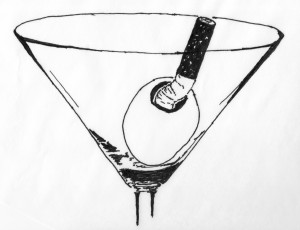Original Artwork by Paul Killebrew
Anyone who has ever looked at a photo of W.H. Auden knows the man enjoyed a good martini in his time. Perhaps one or five too many. "But," the inimitable Rosie Schaap asks in this week's cover story, "what sort of martini?"
She writes:
If Tarquin Winot, the epicurean protagonist of John Lanchester’s The Debt to Pleasure, is to be believed, he made them like so: “I borrowed W.H. Auden’s technique of mixing the vermouth and gin at lunchtime (though the great poet himself used vodka) and leaving the mixture in the freezer to attain that wonderful jellified texture of alcohol chilled to below the point at which water freezes. The absence of ice means that the Auden martini is not diluted in any way, and thus truly earns the drink its sobriquet ‘the silver bullet.’”
It's charming—sort of—to imagine W.H. Auden, with his lined, noble countenance, inventing the progenitor of the jello shot, but Winot, a perverse and unreliable narrator, is not to be believed, and it seems questionable that an Englishman of Auden's generation would abide, much less favor, a martini made with vodka instead of gin.
What would he abide? Join the search over here. And, if afterwards you find yourself a bit parched, the perfect antidote to the office hour blues can be found after the jump.
Rosie Schaap's Martini
A good martini requires a good cocktail glass, one equipped to hold no more than four and one half ounces, and ideally smaller still—not one of those dopey, super-sized glasses that have become ubiquitous, and which often hold ten or more ounces, guaranteeing that the cocktail will become unappetizingly warm about midway through its consumption. Too small, you say? Make another!
Don’t be afraid of vermouth—it’s what makes a martini taste like a martini. I like Noilly Prat, although there’s some controversy because its formula for the U.S. market changed recently. It still tastes good to me. As for the gin, I admit that though I’ve always loved the taste of it, Hogarth—and the scientifically unsubstantiated belief that it has greater depressant qualities than other spirits—put me off the stuff for years. Happily, I’ve come back around. There are all kinds of so-called “artisanal” gins on the market these days, but I stick with good, old-fashioned, relatively inexpensive Beefeater. It’s delicious. And olives? By all means—but in a nice little dish on the side, not in the drink. This recipe makes one three-ounce martini that’s neither very dry nor very wet, but balanced:
2 1/2 ounces gin
1/2 ounce dry vermouth
1 strip of lemon peel
1 fresh mint leaf
Chill a cocktail glass. Fill a mixing glass with good, clean ice, then pour in the gin and vermouth. Stir for about thirty seconds, then strain the liquid into the chilled cocktail glass. Twist the lemon peel over the drink to release a spray of its aromatic oils. Discard peel. Float mint leaf in cocktail. Enjoy!
Thanks, Rosie. I will. And if anyone else has any suggestions for further literary libations, the bar (and the comments) are open.
Travis Nichols is the author of two books of poetry: Iowa (2010, Letter Machine Editions) and See Me...
Read Full Biography


